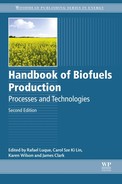10.3. Advantages and limitations
One of the most important advantages of AD is the production of a methane-rich gas (Fig. 10.2). In view of the fact that the feedstocks used for AD are renewable biomass they do not deplete fossil fuels. Moreover, the energy recovery from the biogas does not contribute to greenhouse gas emissions. On the other hand, the utilization of the digestate as fertilizer or soil conditioner reduces the need to produce inorganic fertilizers and, thus, reduces further the fossil fuel consumption required for commercial fertilizer production (Fig. 10.2). As a result, AD provides economic benefits through energy and fertilizer substitution from waste biomass.
Another important advantage of AD is the reduction of the volume of the waste that if released to the environment would cause environmental problems. The hygienic concerns related to uncontrolled waste handling can also be eliminated by AD. The pathogens are reduced especially during thermophilic AD. Furthermore, the odors released during the putrefaction of biomass, particularly in landfills, is prevented by AD. Odorous volatile compounds are converted into methane in closed systems, ie, anaerobic digesters. Fly propagation, which is a major problem, especially in the case of manure, is also prevented by AD.
Methane is a major greenhouse gas and its release to the atmosphere causes serious environmental problems. A well-managed AD would minimize the overall emissions while providing energy recovery in the form of methane. It should be noted that AD does not eliminate the waste completely. However, it is easier to manage the waste using AD compared to other processes such as composting, aeration treatment, mechanical separation, etc. However, AD is a complex biochemical process, which is vulnerable to a number of environmental factors that increase the risk of process failure. The variable nature of the feedstocks during the year may be a problem too; more organic wastes prevail during the summer, while woody biomasses are produced during autumn. Although there are very low-cost small-scale digesters that have been frequently used in farms (especially in developing countries), the cost of this technology increases if reliability and high efficiency are targeted. The design of advanced digesters, application of advance process monitoring and control, or employment of trained technicians raises the cost significantly.
One of the major disadvantages of AD is the requirement for a long start-up period. During the start-up, biogas production in digesters is not effective. The duration of start-up is affected by many factors, such as the composition and the organic loading of the feedstock, the activity and adjustability of the inoculum, environmental factors (temperature, pH, nutrients, etc.), operating parameters (hydraulic retention time, mixing) as well as the bioreactor configuration (Weiland and Rozzi, 1991). Utilizing a pair of anaerobic digesters instead of a single one secures the incessant operation of the anaerobic plant. For example, if one of the digesters has low efficiency or failed due to mishandling or other reasons, the other digester can be used with full capacity, or the first digester can be used to provide an activated, adjusted inoculum that could shorten the acclimation time in the second digester.
..................Content has been hidden....................
You can't read the all page of ebook, please click here login for view all page.

